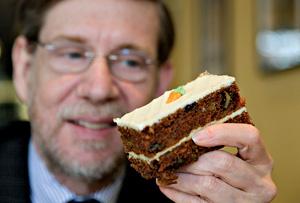The End of Overeating: Taking Control of the Insatiable American Appetite
 David A. Kessler's best-seller explains how overeating becomes an addiction. |
By David A. Kessler ’73, M.D. (Rodale)
Reviewed by Catherine A. Sanderson
The End of Overeating examines a topic with great practical implications—the virtually nationwide obsession with food and, in turn, the veritable explosion in rates of obesity. This book is organized into six sections: the types of food we find appealing, strategies used by the food industry to encourage consumption of particular foods, how we learn to overeat, treating food cravings, strategies for changing what we eat as individuals and changing habits in a broader, societally based way.
In 1960, women ages 20 to 29 weighed an average of 128 pounds; in 2000, women of this age weighed an average of 157. David Kessler, former head of the FDA (and an Amherst trustee), examines factors that led to this massive increase, including portion size, variety and the highly rewarding nature of particular tastes—sugar, fat and salt. These factors help explain why particular foods, and particular situations, often lead to overeating. The most popular foods ordered in restaurants today are often high in one or more of these rewarding tastes (think buffalo wings, potato skins and cheese fries) and are served in obscenely large portion sizes (think “all you can eat” buffets).
Kessler looks at the strategies used, quite successfully, by the food industry to prompt overeating: serving very large portions (making people feel as if they are getting “a deal”), describing food in vivid ways (“succulent Italian seafood fillet” instead of “seafood fillet”) and creating what they call “purple cows”—meals that really stand out, with complex flavors, appealing colors, multiple textures.
The third section of the book, which examines the phenomenon called “conditioned hypereating,” is in some ways the most important, because it describes how overeating can, over time, become automatic. People will eat more and more food to experience the same feeling of reward, and thus, overeating can become truly an addiction, like gambling and substance abuse. Conditioned hypereating explains why simply driving by a restaurant can lead us to crave the foods they serve, why trying to avoid thinking about a particular food we like can increase our desire for that food and how emotional states (stress, anger, anxiety) can lead to overeating.
Are we doomed to overeat, both on an individual and a societal level? Kessler describes a number of strategies to prevent overeating, and, in particular, to break the cycle of conditioned hypereating. These strategies include developing new patterns of responding to tempting situations, forming new—healthier—thoughts in response to appealing foods and having support from family members and friends in making these changes. More broadly, Kessler describes the importance of making changes within the food industry. He suggests requiring restaurants to list the calories of all foods they serve; labeling the percentage of added sugars, carbohydrates and fats on food packaging; and creating widespread public education campaigns about the hazards of foods with high levels of fat, salt and sugar.
Most impressively, Kessler manages to integrate clear descriptions of complex scientific research with engaging real-life examples to vividly illustrate these findings. Readers will learn about current and compelling research, including how the “set point theory” should lead the body to maintain a particular weight and how this set point can change over time, how neurons in the brain respond to particular types of rewarding foods and how people (and even animals) can quickly become conditioned to expect a high-sugar, high-fat snack at a particular time. They will also find illustrative real-world anecdotes, including how Robert De Niro had trouble losing the weight he gained for Raging Bull, why Steve’s Ice Cream “smoosh-ins” became commonplace across the ice cream industry and why many Amherst College students line up for Antonio’s Pizza creations with toppings such as beef taco, chicken quesadilla and potato and bacon.
Despite these strengths, The End of Overeating is not without its flaws. Specifically, almost all readers will learn more than they perhaps want to about the particular foods they crave and how and why these foods are so appealing. Thus, anyone with a particular fondness for a Bloomin’ Onion, Cinnabon or Mocha Frappuccino should be wary about reading this book—and I may never be able to enjoy a Snickers quite as much again.
Amherst Reads has chosen The End of Overeating as its featured book for August 2009.
Sanderson, an associate professor of psychology at Amherst, studies close relationships and health-related behavior, including eating disorders.
Photo property of Associated Press